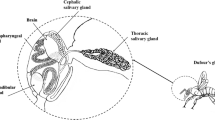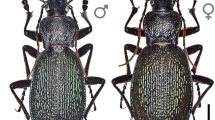Summary.
Worker postpharyngeal gland (PPG) chemistry of Pachycondyla apicalis constitutes a blend of hydrocarbons including alkanes, alkenes, and alkadienes, with 5,9-pentacosadiene, 5,9-heptacosadiene and 5,9-nonacosadiene as the major products as well as fatty acids. There is a large congruency between the PPG and cuticular hydrocarbons, however the latter had higher proportion of tricosane and pentacosane, but only traces of fatty acids. These ants have a well-developed cuticular hair brush on the front legs that they frequently pass through the mouth while grooming. Since these brushes have higher amounts of hydrocarbons than either the middle or hind legs, we hypothesized that they are involved in hydrocarbon circulation. We assessed the role of the front basitarsal brush in hydrocarbon circulation by isolating them from the buccal cavity, either by restraining the front legs or by blocking the mouth with glue. In both experiments, preventing contacts between the basitarsal brushes and the mouth for 24 hrs resulted in a considerable increase in hydrocarbon amounts in the brushes with a parallel decrease in the PPG. When the ants were kept alive for an additional 24 hrs after their legs were freed, hydrocarbon amounts in both the PPG and the front legs returned to normal. Analyses of crop content revealed the same hydrocarbons profile as in the PPG, but their amounts were very variable and there were no differences in amounts between the treatment and the control. We assume that part of the PPG hydrocarbons are cleared via the alimentary canal. Grooming behavior of ants restrained for 24 hrs and then freed was followed for four hours thereafter. There was a significant increase in total grooming during the first third and fourth hour, but not during the second. Grooming involving the front legs-mouth, and front legs-antennae, and the front and hind legs was especially intensive during the first hour. Grooming involving the hind legs – body was more intensive in the treated ants during the third hour following their release. We conclude that the front basitarsal brush is a site of hydrocarbon accumulation and that the PPG receives frequent charging during self-grooming.
Similar content being viewed by others
Author information
Authors and Affiliations
Additional information
Received 25 June 2000; accepted 19 September 2000
Rights and permissions
About this article
Cite this article
Hefetz, A., Soroker, V., Dahbi, A. et al. The front basitarsal brush in Pachycondyla apicalis and its role in hydrocarbon circulation. Chemoecology 11, 17–24 (2001). https://doi.org/10.1007/PL00001827
Issue Date:
DOI: https://doi.org/10.1007/PL00001827




